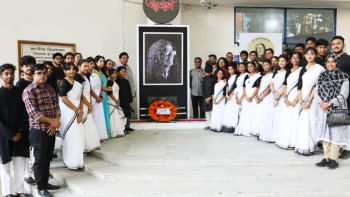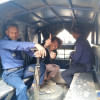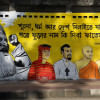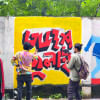The journey of street art in Bangladesh

In April of this year, the Dhaka North City Corporation embarked on a creative endeavour to enhance the visual landscape of the capital city. Their project involved adorning the pillars of flyovers and the metro rail with vibrant graffiti artwork embellished with important awareness messages. Already underway, a team of Dhaka University artists is at work, using their skills to create visually appealing art, while conveying essential messages. These messages aim to discourage unnecessary car horn usage, promote protection against mosquitoes, and combat issues like waterlogging, contributing to both the city's aesthetics and the community's well-being.
But street art's journey isn't confined to beautifying pillars and flyovers. It's a global phenomenon that has transformed from its roots as an act of vandalism into a respected and influential art movement. In Bangladesh, this evolution has taken various forms, reflecting the changing socio-political landscape and the artistic expressions of its people.

In a surprising turn of events, the walls of Dhaka University's campus, historically associated with expressions of rebellion, also underwent a transformation (which didn't last a night). Bangladesh Jatiotabadi Chatra Dal (JCD) launched a graffiti campaign on various campus walls, including the iconic Madhu's canteen, just last month. Notably, this graffiti spree, led by Anisur Rahman Khandoker, a former general secretary candidate, signifies an interesting shift in the perception of street art. Beyond Madhu's canteen, these artistic expressions have left their mark on locations such as the DUCSU (Dhaka University Central Students' Union) Cafeteria and the Arts Building, with over 20 graffiti pieces in total. These urban murals feature slogans like "Save the Country, Save the People" and "Take Back Bangladesh", providing insight into the evolving nature of street art.

This isn't the first time Dhaka has witnessed such graffiti bearing unexplained messages.
Earlier in 2016, another kind of graffiti appeared in Bangladesh's capital, Dhaka. Suddenly, people found examples of strange street art in the Agargaon borough depicting a man running with a cage and a sun trapped inside it. Accompanying the images was an ominous warning– "Subodh tui paliye jaa, tor bhagge kichu nei" (Subodh, run; your luck's run out). Similar graffiti emerged in a number of other areas of Dhaka in the months that followed. People started to share the images on Facebook, and so they soon seemed to be everywhere. But nobody asked who might be painting the images and why. The artwork is signed off with another enigmatic message– "Hobe ki?" (Will it happen?).
Many on social media compared the creator of the graffiti with Banksy, the famous (but anonymous) UK-based graffiti artist and political activist.

The images were created using stencil graffiti and spray paints, a method well-associated with Banksy. The 'Subodh series' also features political messages. Why could the creator of the graffiti want Subodh to run away? Many have contemplated that the artist may be trying to reflect on the social, economic and political crisis in the country.
It serves as a modern manifestation of a long-standing tradition of political graffiti in Bangladesh. The country has a history of using street art to voice opinions, dating back to 1952. During the period of the Language Movement, artists created wall art against the Pakistani government, led by Rafiqun Nabi and other renowned artists. Back then, political persons used to create stencils of their party's symbols on walls. As there is a relation between the existing form of graffiti art in Bangladesh and politics, the number of artworks lessens if the political parties weaken. Despite Bangladesh's lenient laws regarding graffiti, a unique form known as 'chika mara', mainly consisting of political slogans and advertisements, dominates the public wall. Leftist parties used to use the medium of chika mara to spread their slogans and socio-political messages. But as their dominance decreased over time, artworks reflecting their ideals also diminished.

Chobir Hat played a key role in instigating the earliest steps of out-of-norm graffiti art in Bangladesh. Chobir Hat's aim was to change art's captivity from amongst enclosed gallery spaces and aristocrats, to bring out art in the open for regular people. But Chobir Hat finally turned out to be an open gallery and failed to spread graffiti as a culture, as graffiti art is considered a cultural movement when it is found randomly in various corners of a city or country.
Many years ago, in the dimly lit alleys of New York City's Lower East Side, a similar form of street art, like Subodh series, emerged. In the late 1960s, a cultural revolution was quietly taking shape. Fueled by a sense of rebellion and a desire for self-expression, a group of artists began to make their mark on the urban landscape in a way that would eventually transform the art world forever. This movement, known as street art, has evolved from 'an act of vandalism' to a globally recognised and respected art form, with roots that run deep into the fabric of contemporary culture.
Street art's origins can be traced back to the graffiti tags that began appearing on the streets and subways of New York City in the late 1960s and early 1970s. These crude, stylised signatures were often seen as acts of rebellion and vandalism, with authorities cracking down on those responsible. However, what started as an underground form of self-expression soon evolved into something more significant.
One of the pivotal moments in the history of street art was the emergence of artists like Jean-Michel Basquiat and Keith Haring in the 1980s. They brought a new level of sophistication and social commentary to the streets, using public spaces as their canvas to convey powerful messages about race, sexuality, and inequality. Their work blurred the lines between graffiti and fine art, challenging the conventional notions of what art could be.

As street art continued to evolve, a new generation of artists emerged, each with their own unique style and message. Banksy, the enigmatic British artist, became one of the most influential figures in the street art world. Known for his politically charged and thought-provoking works, Banksy's pieces could command millions of dollars at auction houses – a testament to the mainstream acceptance of street art.
Other prominent street artists like Shepard Fairey, who created the iconic 'Hope' poster for Barack Obama's 2008 presidential campaign, and JR, who has brought attention to global issues through massive public art installations, have also played a crucial role in elevating street art to new heights. While street art was born in the streets of New York City, it quickly spread across the globe. Cities like London, Berlin, and Sao Paulo became hotbeds of street art, with local artists adding their voices to the movement.

In this global context, Bangladesh has also made a significant mark on the world of street art. While graffiti art, mainly artworks done on walls, is getting widely popular in developing countries like India, Iran, China, etc, as a culture, in Bangladesh, it remains an individual effort. In Dhaka, the capital city of Bangladesh, a vibrant street art scene has taken root. Artists like Ariful Haque, known as Ink Bandit, and Ashim Halder Sagor have used their art to address pressing social issues, from climate change to women's rights. Their work not only beautifies the city but also serves as a powerful form of social commentary, challenging societal norms and sparking important conversations.
Street art, from its rebellious beginnings on the streets of New York City to its current status as a respected and sought-after medium of art – around the world, has become a testament to the power of art to challenge norms and spark change.
However, the emergence of the above-mentioned Subodh series of graffiti in Bangladesh underscores the evolving nature of street art and its intersection with the socio-political landscape of the country. Just as street art has transcended its origins as vandalism to become a respected art form on the global stage, it has also found a unique voice in Bangladesh, addressing critical issues through visual storytelling. In a country with a long and rich tradition of political graffiti, such a series of street art represents a modern manifestation of the art form. It serves as a reminder that street art continues to be a dynamic force in shaping the socio-political discourse that provokes thoughts and fosters dialogues.
As artists in Bangladesh continue to embrace street art as a means of creative expression and social change, their work adds a unique and powerful dimension to the global conversation around urban art.

 For all latest news, follow The Daily Star's Google News channel.
For all latest news, follow The Daily Star's Google News channel. 








Comments